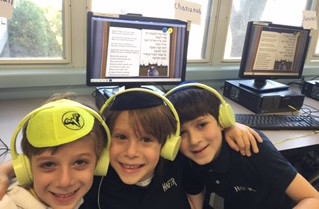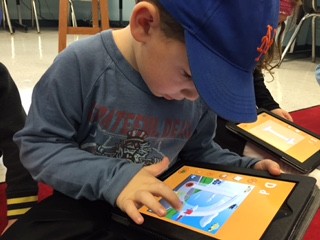HAFTR applies hi-tech throughout school
‘People of the iPad'
How do we prepare kids for jobs that don’t exist yet?
This is the question the Education Technology team at Hebrew Academy of Five Towns and Rockaway has been puzzling through for the last two years, developing novel approaches for K through 12.
“Sixty-percent of today’s kindergarteners will have jobs that do not exist yet,” said Ben Gross, HAFTR’s education technology director, “such as in robotics and STEM (science, technology, engineering and math) fields. Giving the kids these basics will get them prepared for virtually anything.”
Lower school principal Joy Hammer said that parents, keen to visualize what’s going on in technology at the school, are always welcome to drop in. “They won’t see a gimmick that we could say ties into math,” she said. “We figure out where math intersects with real life.”
Hammer used as an example a robot drawing a circle: “Once they figure out the relationship between the robot moving, the students prove their hypothesis by writing an equation describing the angle of the robot’s turn, divided by 360 degrees, divided by the distance that the robot goes forward, times the circumference.” The next question she asked the youngsters was how many rotations it would take for the robot to travel 10 meters. “Yes, we are doing this in lower school,” she said.
To get lower school students familiar with computer programming, they are introduced to logic and problem-solving when coding steps are acted out through balls and arrows placed an a carpet of colored squares in the center of the computer lab. Morah Elaine Gross’ second grade students are well-versed in what an algorithm is: a list of steps that allow a task to be completed. “We use the example of brushing your teeth,” she said. “When a machine follows that set of tasks, it is called a program.”
Edit Boral works with students on the “3Cs, which are necessary for any success in life: collaborative work, creativity, and critical thinking.” Thanks to her ingenuity, HAFTR’s fourth graders teamed up with high school counterparts to create a unique centerpiece for the school’s Evening of the Arts — a Kandinsky-style mural painted in electricity-conducting paint that lies atop circuitry they’ve built. Thanks to accompanying software created by HAFTR High School seniors, when any part of the mural is touched, it will emit a musical tone keyed to its color; Kandinsky theorized that every color has its own sound (yellow is middle C played by trumpet, for example).
“Nobody has done anything like this, except perhaps MOMA,” Boral said. “The students truly claim ownership of their learning with a project like this.”
Gross pointed out that HAFTR’s system is not to simply hand out an iPad to every student, but rather to carefully choose where technology fits in the curriculum and then use it judiciously. “We use tech as an enhancement to learning, not the main attraction. We are not what’s referred to today as a ‘blended learning’ school; we’re a school, and technology has to fit properly teacher by teacher in each lesson.”
The school is committed to providing adequate professional development time for teachers to train in the best ways to use apps in the classroom, he said.
Baruch Noy, previously a classroom teacher in both general and Judaic studies, is now the ed tech specialist for grades 3 through 5. He asks teachers where they see tech helping with their teaching goals. “Then I can find and show them tools that can support what they want to accomplish,” he said.
In Rabbi Rodney Weiss’ fifth grade Talmud class, each test he gives utilizes three apps: Zaption, with interactive videos; Flipquiz, which sets up a Jeopardy-style game; and Quizlet, which creates flash cards.
The ed tech expansion is rapidly moving throughout all grades, and next up is a new technology lab in the old high school gym. This will incorporate maker space (where students tinker, design and create), a film studio with a green screen, 3-D printers that will be used to learn about neural synapses and the Mishkan, a computer numerical control router and fabrication lab.
Jay Aaron teaches AV to high school students, who live-streamed the Satrin basketball tournament over a four-day weekend earlier this year. It got over 15,000 views. “It was a student-oriented project that worked well for the kids educationally,” Aaron said.
The high school is also creating an entrepreneurial initative with Israeli company FreshBiz, which teaches students business skills through game-based learning. This partnership will result in a high-end curriculum to teach business skills to the upper grades.
Gross summed up HAFTR’s mission by saying that education tech “is another way we can be a light unto the nations. Not only are we people of the book, we are also people of the iPad. We want to make education integral to Jewish identity and survival.”
HAFTR has partnered with several corporations and has received grants to cover the costs of all the hardware and software the school is now using, so this tech expansion has not caused tuition to rise.

 39.0°,
Fair
39.0°,
Fair 







